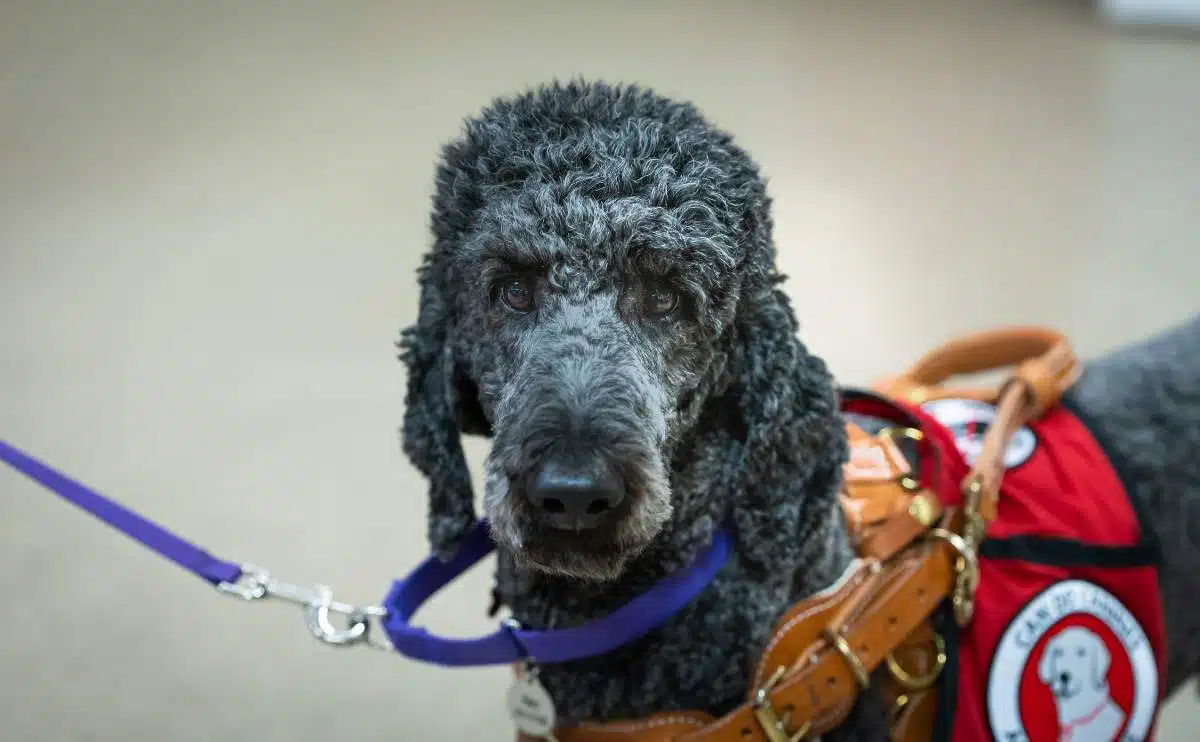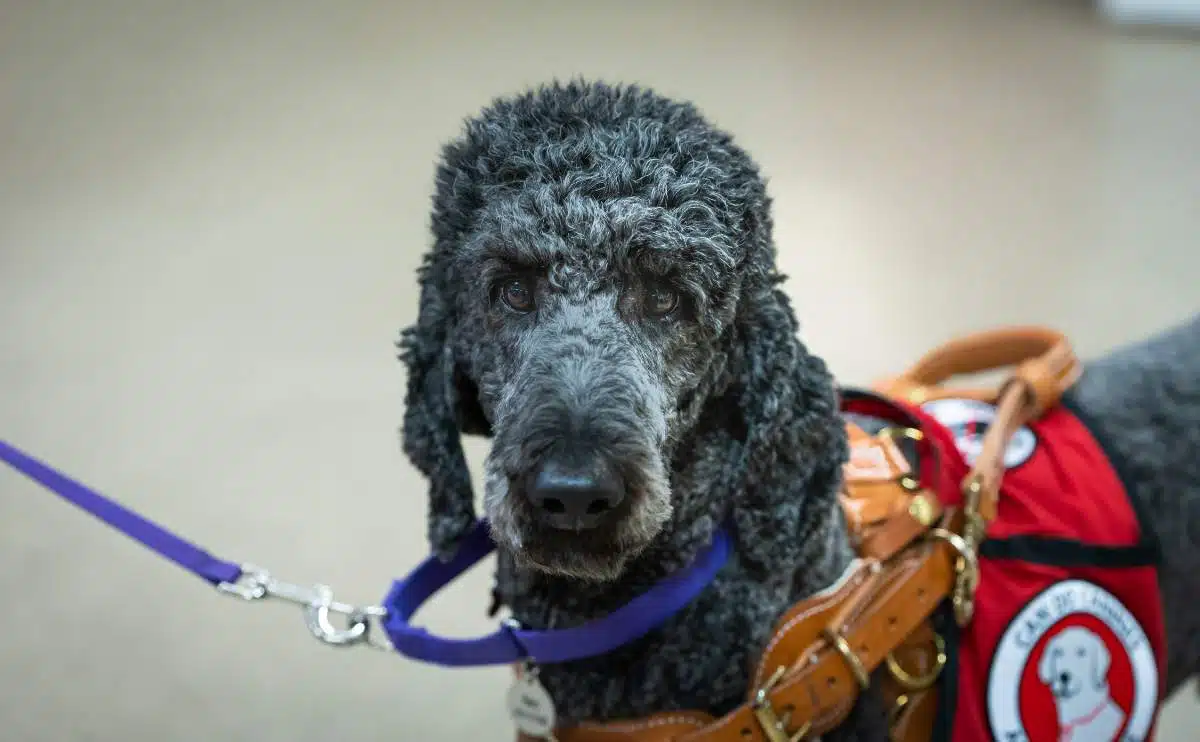
To keep the lights on, we receive affiliate commissions via some of our links. Our review process.

If you are considering an emotional support dog, there are a few things to know first. Any breed can be an emotional support animal (ESA), but some are better suited to the role than others. The deep connection owners feel with their pets is therapeutic for all owners, but for those who need an extra level of support, a dog can make a significant, positive impact in their lives. Let’s take a moment and learn more about the best emotional support dogs and the breeds that many people pick.
What Is An ESA Dog?
Contents
Emotional support animals are companion animals that help owners manage disabilities and conditions such as anxiety, depression, loneliness, Post Traumatic Stress Disorder (PTSD), phobias, and more. While everyone bonds emotionally with their pets, ESAs are prescribed by a medical doctor. They are defined as animals that provide emotional and therapeutic support and benefit to people suffering from some emotional issues or psychiatric conditions.
ESA vs. Service Dogs
ESAs differ from service or therapy animals. These pups are not trained in precise skills like support animals but are trained to help specific people. A service dog can be trained to help with both physical and mental disabilities. For example, service animals are trained to retrieve objects, help with medication, assist with tasks, aid in mobility, and alert people to oncoming symptoms like seizures or panic attacks, among other precise skills.
- ESAs primarily provide benefits through companionship, though some may be trained to do specific things.
- Unlike service dogs, there are no specific training requirements for emotional assistance dogs. ESAs may or may not have special training and are not given the same level of access to public spaces as service dogs.
- ESAs do not have the same legal protections as service animals, but they do have some. The Fair Housing Act (FHA) states landlords cannot deny tenants with emotional support animals. They must also make reasonable accommodations for these tenants.
- To be eligible for legal protections, owners must have documentation from a licensed mental health professional that expresses that an ESA is part of a treatment plan. Online certification may not always be accepted.
- ESAs offer companionship, reduce anxiety and depression, provide support for anxiety and PTSD, give owners a sense of purpose, boost self-esteem, increase owner’s activity levels, strengthen social connection, and even have physical health benefits for owners.
13 Best Emotional Support Dog Breeds
Many different canine breeds can be ESA dogs. Technically, any dog can be an ESA if owners get an official letter. That said, some breeds are better suited to provide the kind of reassurance ESA owners need. For example, people with anxiety and panic disorders often do better with larger dogs. Larger dogs provide a sense of safety and security, so they work well with people who feel lonely, unsafe, scared, depressed, anxious or need physical support.
Smaller breeds often have more energy and may be better suited to people with hyperactivity, trouble focusing, or learning disabilities. Keep in mind that each person and dog is different, and finding the perfect fit is not always as easy as picking a specific breed. Look for breeds that bond quickly with people, are healthy, older than 12 months, trained and socialized, are affectionate, and do not mind physical touch.
Let’s get to know some of the top 13 breeds for emotional support dogs. We have listed these in alphabetical order.
1. Beagle
Beagles are highly alert animals who can learn many tasks to help others. They are also very calm and naturally sensitive to human emotion. Beagles have a calm temperament with a highly tolerant nature. The breed is also famous for being unrelentingly loyal and will stick by their owner’s side through everything. Along with being sweet-natured, Beagles are energetic. They require daily exercise, which helps owners get more physical activity themselves.
2. Cavalier King Charles Spaniel
The spunky Cavalier King Charles Spaniel is another top pick, sometimes said to be the top pick for an emotional support dog. Cavaliers were bred to be companion dogs, and they live up to the task perfectly. The breed is famous for their excellent manners and adorable features. A bonus is that the Cavalier is the perfect size for homes of any size, including apartments. Cavaliers are highly trainable and love to please.
Cavaliers are not independent and want to spend every second possible with their people. This sweet nature makes them perfect for people who need emotional connection and support.
Our Personal Experience With A Cavalier King Charles Spaniel Emotional Support Animal
“Our 4 year old rescue Cavalier was an ESA for a few years. She not only brought comfort to me, she helped bring a smile to the faces of kids and elderly people who were disabled. Something about her calming presence put everyone at ease and petting her provided a healthy mental and physical distraction.”
– Cavalier King Charles Spaniel parent
3. Chihuahua
Chihuahuas, the smallest dog breed on earth, can be high-strung, but they can also be some of the best, most supportive animals around. Chihuahuas have fiercely loyal natures, lovable personalities, confidence, and strong bonds with owners, making them suitable for various needs. They can learn to do tasks, including providing physical pressure, retrieving items, and providing reassurance. Chihuahuas are very protective, which provides security and reassurance. Chis are also very in tune with how people feel and will be right there next to them to work through panic attacks, anxiety, and other symptoms that may affect them.
4. Corgi
The undeniably cute Corgi is a very amicable pup, making them highly suitable for an ESA role. Corgis are small and only reach about 40 pounds when fully grown, so they fit in with many different types of homes. Corgis are very loving, with a cheerful look and personality. They are medium energy and easy to train with positive reinforcement. Corgis have a very amicable, mellow temperament. Along with that, Corgis are extraordinarily loyal, which makes them a good pick for emotional support.
5. Golden Retriever
Golden Retrievers are another top pick, often taking the lead in top picks for ESA, therapy, and service dogs. Goldens are famous for their loyalty, which is pivotal when providing reassurance and comfort. They’re also highly attentive, making them a top pick for children. Goldens are highly trainable and very smart. They understand direction and can learn to do specific tasks for their owners. Goldens are vigilant and aware of what is happening around them. This sensitivity is a huge part of what makes the gorgeous Golden Retriever a top pick for an ESA.
6. Great Dane
Great Danes are a substantial-sized breed but are not aggressive in nature. In fact, the Great Dane is known to be a giant sweetheart and quite docile. Their loving personality and calm temperament make them an excellent pick to assist people with certain emotional needs. The Great Dane’s large size offers stability, protection, and a sense of security. Their personality, loving nature, and attachment to people make them wonderful companions. While they do need exercise, this giant breed needs less than one might think. They are lower maintenance than some smaller breeds but do have their own set of unique health needs. The Great Dane’s high intelligence, gentle personality, and large size make them popular for supportive and therapeutic work.
7. Havanese
Havanese are small, calm, and empathetic. They can sense a shift in emotion and recognize when owners are not feeling well. Havanese are very calming due to their sweet temperament and sensible nature. These little pups are also quite intelligent and can be trained to do many things. They are reliable once they have learned something and are much lower maintenance than some other larger, more energetic canines. Havanese are known to be very clingy, but when properly trained and socialized, this attachment can benefit people who need them for supportive reasons.
8. Labrador Retriever
Labrador Retrievers are a top pick for many reasons. For many, they take the number one spot. Labradors have several characteristics that make them effective ESAs. These include high trainability, a friendly nature, and their larger size. Labs have a sweet temperament and are very dependable. Their primary motivator is food, so Labs can easily be trained to help out and know how to help their owners. This includes companionship and laying their large bodies on or hear owners, which is comforting and offers pressure to relieve stress.
9. Maltese
Maltese are one of the cuddliest, fluffiest breeds and among the best choices for an ESA. They become very attached to their special people and want to be close to them all the time. The ability to quickly bond with their owners and their empathy towards people is part of why the tiny Maltese is a top pick for compassion and care. Reaching between 4 and 8 pounds, these fluffballs are welcome almost anywhere, which is helpful for people who need to bring an ESA with them on errands and social events. Maltese do not need as much exercise as some larger breeds and can live happily in small spaces like apartments. They are also a good pick for people who have mobility concerns, as they do not need much room to get enough exercise.
10. Poodle
Poodles of any size can make fantastic support animals. They are eager to please, intelligent, and very adept at handling unexpected situations. Poodles are intuitive and can pick up on emotions, psychological changes, or distress, a desirable trait in an ESA. Poodles are incredibly focused and prefer people to other dogs. They are an active breed, which helps get owners out and about, increasing physical exercise. Rarely are Poodles aggressive, all good qualities for providing stability and comfort to others. Additionally, Poodles are hypoallergenic, making them fit for people with allergies.
11. Rough Collie
The Rough Collie, or Collie, is a wonderful pick for an ESA. Collies are famous for their highly intuitive nature. They are very responsive to human emotion and sense when someone needs support. Collies are a top pick for people with anxiety and depression due to their way of recognizing when someone is in distress. The Collie is a characteristically calm breed, though will be wary of strangers. This protective nature is part of what makes them highly effective ESAs for some people.
The Border Collie is also a lovely pick for assistance animals. They are super smart, often called the most intelligent breed. Their high level of smarts makes them easily adaptable and easily trainable.
12. Yorkshire Terrier
Yorkshire Terriers, or Yorkies, are quickly lovable due to their adorable looks, small size, and vibrant personality. These pups reach just 4 to 7 pounds on average but pack a whole lot of character into that tiny frame. Yorkies are high-energy and very affectionate. Their small size makes them easy to take almost anywhere, and no one is threatened by their size or demeanor, which is helpful for an ESA. This means they can help people with anxiety or who get confused in public. Yorkies can quickly learn obedience and special skills to help their owners.
13. Mixed Breeds
Assistance or supportive dogs do not need to be purebred. Mixed breeds of unknown origin, as well as designer crossbreeds, can all be fantastic service dogs. Of course, as with any other breed, this depends on the animal, specific genetics, and upbringing. Poodle mixes like the Goldendoodle, Poogle, Labradoodle, and more are popular picks due to their adorable appearance, intelligent nature, and strong personalities. Breeds like Bulldogs, though often stereotyped for aggression, can be loving, attentive companions when raised and trained correctly.
The breeds discussed above are some of the best types of emotional support dogs, offering stability and reassurance. However, any canine breed can be an ESA. Bigger canines offer a sense of security, safety, and calm, while smaller breeds offer constant cuddles, empathetic understanding, and affection. The best pick is an animal that fits your lifestyle, is easy to train, good-natured, and suits your specific needs. Determining what characteristics in a breed you hope to find before bringing home a new pup is wise. Owners should also learn more about the breed and be prepared with all the necessary supplies like beds, toys, food, food bowls, and an understanding of the training required.
How To Get An Emotional Support Animal Letter
Getting an ESA letter offers protection for owners and their animals. Registration is generally not a requirement. In most cases, landlords will want to see the official letter. This letter must come from a licensed psychiatric or medical professional. Essentially, this letter is a prescription and may specifically list dogs, depending on the provider who writes it.
See below for an example of an ESA letter from one of our team members.

Owners will need to have a consultation and appointment with a licensed medical and mental health professional to explain why they need this assistance and how it will benefit them. The doctor will then determine if ESA will be a beneficial part of a treatment plan. Owners may speak to their providers or go through an online service. Once they get approved and have the letter, this will provide specific benefits and protections, including allowing dogs to live in no-pet housing. An ESA letter may also impact flying with your dog. However, each airline has its own policy.
Emotional Support Dogs vs. Service Animal vs. Therapy Dog
There are many questions and significant differences exist in training, use, legal requirements, and legal protections between different types of working dogs. Learn more in our ESA, service, and therapy dogs guide.
If you are considering a support animal of any kind, be sure to do diligent research and preparation first. While ESAs are amazing and often make an immeasurable difference in the quality of life of their human family, they are animals who need high-quality care and training. The owner is responsible for regular veterinary checkups, daily exercise, high-quality, age-appropriate nutrition, access to toys, daily care, and consistent training. Supportive animals form a close, reciprocal bond with their owners, but the owner must provide the best care possible. Like any other pet, these pups need to feel respected, loved, and safe.
Tagged With: